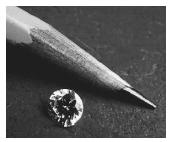Carbon

MELTING POINT:
3,500°C
BOILING POINT
: 4,827°C
DENSITY
: 2.62 g/cm
3
MOST COMMON IONS
: CO
3
2−
, HCO
2
−
Carbon is the sixth most abundant element in the universe and possibly the most widespread element on earth. Named from the Latin word carbo , meaning charcoal, it has been known since ancient times, although not recognized as an element until more modern times. It is found in all living things, but is also commonly found in minerals such as limestone and marble and as a small but important constituent of the atmosphere, as carbon dioxide.
In its elemental form, carbon can be found as diamond, the hardest naturally occurring substance; graphite, an excellent lubricant; or as a fullerene (or "buckyball"). Although five isotopes are known, only C-12 (98.9 percent natural abundance) and C-13 (1.1 percent) are stable. Nevertheless, the presence of trace amounts of C-14, a radioactive isotope (with a half-life of 5,730 years), permits "carbon dating" of historical objects.
Carbon is unique among the elements in that carbon atoms can form bonds with other carbon atoms. This property, known as "concatenation," is the reason that there are more than several million known organic (containing carbon) compounds.

Carbon is a major constituent of most of our fuels—natural gas, petroleum, coal, wood, and other biomass . When burned for their heat content, these fuels produce carbon dioxide, which escapes into the atmosphere. In the "carbon cycle," this carbon dioxide is trapped by plants and reincorporated into useful substances such as cellulose and starch via photosynthesis. Since the Industrial Revolution of the nineteenth century, which greatly increased the quantity of fuel combustion , the concentration of carbon dioxide in the atmosphere has increased. This atmospheric change has been implicated as the cause of global warming.
Carbon is a major constituent of most polymers, both naturally occurring ones such as cellulose, starch, RNA , DNA , silk, and wool, as well as synthetic ones, including nylon, Teflon, polyethylene, and polystyrene. Some of the strongest and most modern materials replacing metals are made of carbon fibers.
SEE ALSO Allotropes ; Global Warming ; Organic Chemistry .
George H. Wahl Jr.
Bibliography
Internet Resources
Jefferson Lab. "It's Elemental: The Element Carbon." Available from http://education.jlab.org/itselemental/ele006.html .
Comment about this article, ask questions, or add new information about this topic: